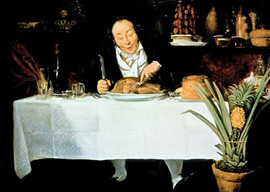
April 08, 2011

The Gourmand by Louis Léopold Boilly
Liebling died two months after his 59th birthday. It is said that his fingers, toes, and even his ears were disfigured by gout.
Boswell said in 1763 that Dr. Johnson’s appetite “was so fierce, and indulged with such intenseness, that while in the act of eating, the veins of his forehead swelled, and generally a strong perspiration was visible.” The great lexicographer and literary critic was “not a temperate man either in eating or drinking.”
The classical archetype of the glutton or gourmand as writer is perhaps Archestratus, a contemporary of Aristotle, whose poem “Life of Luxury” has come down to us in fragments and references from later writers. He was a dedicated hedonist who, according to James Davidson in Courtesans and Fishcakes: The Consuming Passions of Ancient Athens, “sailed the known world of his day for the sake of his belly and the parts beneath his belly.” For the scholar seeking further knowledge, Professor Davidson teaches courses in Greek sex and Mediterranean eating at the University of Warwick, Coventry. Fucking and eating; how come they didn”t teach this stuff when I was in college?
Books by chefs are often boring. I”ve read works by Carême, who was known as “King of Chefs and the Chef of Kings,” as well as Escoffier’s Le Guide Culinaire, but for my money these are how-to tomes. The best writers on eating are not the chefs but the trenchermen.
Among the most scintillating was French judge Jean Anthelme Brillat-Savarin, who in 1825 published The Physiology of Taste. He formulated the notions that the right order of eating is from the most substantial dish to the lighter and of drinking from mild wine to the headier.
It was this gourmand-philosopher who memorably said, “Tell me what you eat and I”ll tell you what you are.” And in an obiter dictum that resonates to this day, he warned that “The destiny of nations hangs on the way they feed themselves.”